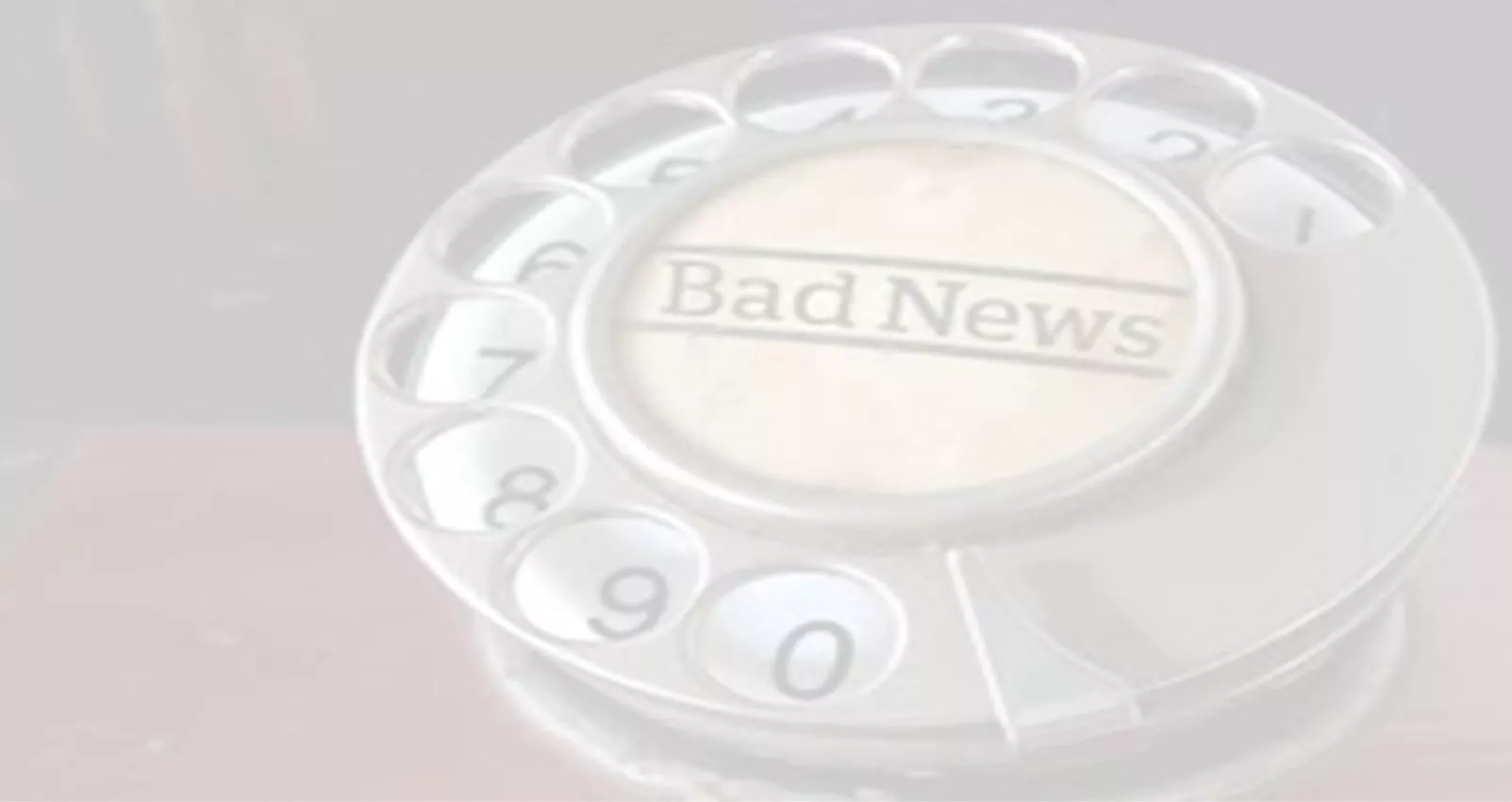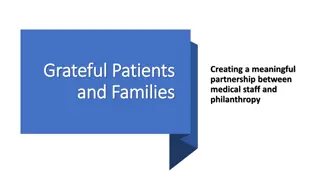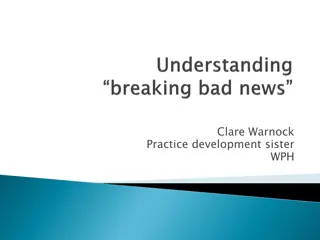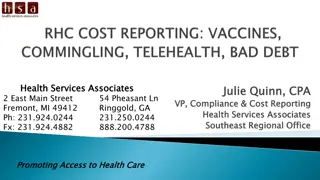Breaking Bad News in Healthcare: Best Practices and Strategies
Understand the definition of bad news in healthcare and learn effective ways to deliver such news, role-playing scenarios, and quizzes to test your knowledge and skills. Explore examples, steps, and considerations crucial for primary care physicians in these situations.
Download Presentation

Please find below an Image/Link to download the presentation.
The content on the website is provided AS IS for your information and personal use only. It may not be sold, licensed, or shared on other websites without obtaining consent from the author. Download presentation by click this link. If you encounter any issues during the download, it is possible that the publisher has removed the file from their server.
E N D
Presentation Transcript
Fahad khalid alotaibi 433100080 Abdullatif mohammed Alhassan 433101443 Ahmed Abdulaziz Aldakhil 432102119
Objectives: Definition of bad news. How to breaking bad news Role of primary care physicians. Examples of how to break news. Video Quizzes
Quiz(1) Which one of the following is the fourth step in breaking bad news: A- Perception B- Knowledge C- Summary E- Setting F- Emotions
Quiz(2) An angry relative of a patient with non-curable STD. What would you do in this case: A. B. C. Tell the nurse to tell the relative that you left early. Tell the relative everything about your patient condition. Tell the relative that the patient's condition can be easily cured with some medications. Let the relative talk and revile why he's angry. D.
Quiz(3) A pregnant patient comes worried that her baby isn't moving; U/S shows no heart beat: A. a. Ask the patient if she understands what "absent heart beat on US" means. B. Tell her that most probably the US technician pushed violently against her abdomen. C. Ask the patient if she's fallen down the stares or wasn't careful with the pregnancy.
Quiz(4) You're about to tell a couple that their baby has Down Syndrome. What wouldn't you do: A. B. Maintain eye contact while delivering the news. Ask the parents "Do you have any questions or concerns regarding Khalid's condition? Write down the diagnosis and treatment options. Tell them about DSCA and provide them with the website information.Tell them "Your baby has a mental condition that'll make him handicapped and it's going to make your life and his very difficult" C. D.
Quiz(5) according to survey that was conducted in Riyadh 2009, what was the percentage of participant want detailed information about the disease? A. a-59% B. b-88% C. c-71% D. d-43%
Definition of bad news Any news that drastically and negatively alters the patients view towards his future. Buckman R. BMJ1984 "Bad news" has been defined as any information which adversely and seriously affects an individual's view of his or her future; whether news is bad or not can only be in the eye of the beholder. The news may be cancer but it may equally be Parkinson's disease, rheumatoid arthritis, schizophrenia, psoriasis, diabetes or any other life-altering disease.
Importance of breaking bad news: Ethical and Legal Imperatives Physicians may not withhold medical information even if they suspect it will have a negative effect on the patient. In North America, principles of informed consent, patient autonomy, and case law have created clear ethical and legal obligations to provide patients with as much information as they desire about their illness and its treatment oldberg RJ. , Annas G. Clinical Outcomes How bad news is discussed can affect the patient's comprehension of information satisfaction with medical care , level of hopefulness and subsequent psychological adjustmen . Many patients desire accurate information to assist them in making important quality-of-life decisions
Methods of breaking bad news Rabow and Mc phee s (ABCDE) approach Baile and Buckman (SPIKES approach) SAAIQ emergency approach-Pakistan BREAKS approach by IJPC SAD NEWS approach- Q.U \ Canada
In this lecture ,we will discuss tow common approaches for how to break bad news 2-Baile and Buckman (SPIKES approach) 1-Rabow and Mc phee s (ABCDE approach)
ABCDE approach A ADVANCE PREPARATION -Familiarize yourself with the relevant clinical information -Arrange for adequate time in a private, comfortable location -Prepare emotionally B BUILD A THERAPEUTIC ENVIRONMENT/RELATIONSHIP - When possible, have family members or other supportive persons present - Introduce yourself to everyone present and ask for names and relationships - Foreshadow the bad news, I m sorry, but I have bad news. - Use touch where appropriate. (Be sensitive to cultural differences) - COMMUNICATE WELL - Ask what the patient or family already knows and understands. - Speak frankly but mercifully . Avoid Using the words cancer or death - Have the patient tell you his or her understanding ofwhat you have said. Encourage questions DEAL WITH PATIENT AND FAMILY REACTIONS Assess and respond to emotional reactions Be empathetic ENCOURAGE AND VALIDATE EMOTIONS Offer realistic hope Even if a cure is not realistic Explore what the news means to the patient
SPIKES approach Setting up the interview S Perception of the patient re their illness P Invitation from patient to share information I K E S Knowledge and Information conveyed Emotions responded to empathically Summary and Strategy for follow-up
Setting 1) Setting up the interview Avoid telephone Private setting, sitting down Turn off beeper, no interruptions Ensure adequate time Lab reports, X-rays present Support person present , if desired Review the condition, basic prognosis and treatments before the visit HOPEFUL TONE
Perception 2) Assessing the patient s Perception ASK then TELL Important if the patient is not well known to you OR if visits to consultants have occurred Assess the Gap What have you already been told about might be going on? What is your understanding of why the CT scan was ordered?
Invitation 3) Obtaining the patient s Invitation Preferably before the visit Easier if patient is well- known Listen to patient cues Are you the sort of person who likes to know all the details of your condition? Would you like me to discuss the results of the CT scan with you?
Knowledge 4) Giving Knowledge and Information Align yourself with the patient s understanding and vocabulary Start with a warning shot: I m afraid that the scan shows that the problem is fairly serious. Silence Give diagnosis simply, avoid euphemisms or excessive bluntness Provide information in small chunks Check frequently for understanding
Knowledge 4) Giving Knowledge and Information Check for knowledge or experience with condition Allow for pauses, use repetition Will usually want basic but clear information retreatment plan and prognosis BUT Tune into patient readiness to hear more, and know when to stop
Balancing Truth and Hope : The Skillful Use of Indirect Language S Healing et al 2006 It looks like . not You have . there are tumours in the liver not you have tumours in your liver Emphasize on maintaining the relationship as well as communicating the news
Emotions 5) Respond to Emotions empathically Observe Observe for and allow emotional reactions use of touch (-_-) Naming the feeling I know this is upsetting Understanding It would be for anyone Respecting You re asking all the right questions Supporting I ll do everything I can to help you through this.
WHATI IS PREIMARY CARE ? Primary care: is that care provided by physicians specifically trained for and skilled in comprehensive first contact and continuing care for persons with any undiagnosed sign, symptom, or health concern (the "undifferentiated" patient) not limited by problem origin (biological, behavioural, or social), organ system, or diagnosis. A primary care physician: is a specialist in Family Medicine, who provides definitive care to the undifferentiated patient at the point of first contact, and takes continuing responsibility for providing the patient's comprehensive care.
Role of primary care physician in BBN Discuss diagnosis, disease course, therapeutic options, patient/family values and goals, and treatment. Breaking bad news understand changes in prognosis ,discuss the advantages and disadvantages of experimental treatment , discuss palliative care options such as hospice. Communicating prognosis the goal is improving quality of life, including treatment of metastatic disease that is causing symptoms. Discussing disease transitions after referring the patient to a subspecialist, request patient schedule follow-up visits; ask the subspecialist to update you on the patient's care. Coordinating care Allow the patient to express emotion; answer questions and address concerns; provide emotional support and empathy Providing support
Role of primary care physician Communicating bad news is an essential skill for primary care physicians. When patients are diagnosed with cancer, primary care physicians often must deliver the bad news, discuss the prognosis, and make appropriate referrals. When discussing prognosis, physicians should be sensitive to variations in how much information patients want to know Who should tell? Sometimes there isn t a right answer to this question. At times, the primary caregiver may be the best person to deliver bad news. However, often, it s the specialist or another caregiver that finds him/herself in a position to give the news to the patient. In any case, the care team should do its best to work together and deliver care as effectively as possible.
Role of primary care physician There are times when patients have been told bad news by clinical specialists within secondary care, but have not fully absorbed or understood the information. In these cases, the role of general practitioner is to go through this information with them again. In some situations, preliminary investigations reveal a high index of suspicion for certain diseases or malignancies, and it is a role of GP to go through the information with these patients prior to referring them for a definitive diagnosis. The 'connecting' and 'summarising' stages of Professor Roger Neighbour's consultation model may be especially relevant. CONNECTING summarising Try to see the world through the patient's eyes, and discover his agenda or priorities. Useful phrases include How are you getting on? What did they tell you at the hospital? Is there anything you want to know about your tests/illness/operation? Be alert for unspoken as well as spoken answers. Feelings perceptible at the edge of the discussion will probably indicate the the real state of affairs better than the facts actually discussed. Reflect back to the patient the impression that you have gained of the situation. This shows that you have understood his/her feelings and gives the patient a chance to correct, refine and expand on them.
Example A 54-year-old male presented to the clinic with dry cough, persistent fever, and night sweats. He s following up with the physician to review his lung biopsy results, which is showing adenocarcinoma. How would you deliver that bad news ? Follow S.P.I.K.E.S. approach
Case scenario During morning clinic, you receive a phone call from the radiologist at your local hospital. A chest x-ray carried out on Mr. muhannad shows features highly suggestive of lung cancer. You remember that Mr. muhannad is a 56year old in your practice area. What problems confront you and how could they be dealt with?
Video: https://youtu.be/end3tWbdUPQ Role play:
Summary 1. Breaking bad news can be stressful but needs to be done effectively in primary care. 2. Bad news can be anything from a diagnosis of diabetes or infertility to cancer. 3. Communication skills are important and Professor Roger Neighbour's consultation model may be useful. 4. The SPIKES approach provides a framework to use when breaking bad news.
Quiz(1) Which one of the following is the fourth step in breaking bad news: A- Perception B- Knowledge C- Summary E- Setting F- Emotions
Quiz(2) An angry relative of a patient with non-curable STD. What would you do in this case: A. B. C. Tell the nurse to tell the relative that you left early. Tell the relative everything about your patient condition. Tell the relative that the patient's condition can be easily cured with some medications. Let the relative talk and revile why he's angry. D.
Quiz(3) A pregnant patient comes worried that her baby isn't moving; U/S shows no heart beat: A. a. Ask the patient if she understands what "absent heart beat on US" means. B. Tell her that most probably the US technician pushed violently against her abdomen. C. Ask the patient if she's fallen down the stares or wasn't careful with the pregnancy.
Quiz(4) You're about to tell a couple that their baby has Down Syndrome. What wouldn't you do: A. B. Maintain eye contact while delivering the news. Ask the parents "Do you have any questions or concerns regarding Khalid's condition? Write down the diagnosis and treatment options. Tell them about DSCA and provide them with the website information.Tell them "Your baby has a mental condition that'll make him handicapped and it's going to make your life and his very difficult" C. D.
Quiz(5) according to survey that was conducted in Riyadh 2009, what was the percentage of participant want detailed information about the disease? A. a-59% B. b-88% C. c-71% D. d-43%
References: Breaking bad news lecture by PROF.HANAN HABIB and DR.KAMRAN SATTAR Perception and Attitude towards Breaking Bad News in the Saudi Population (by Prof. Mohammed O. Alrukban ) http://www.aafp.org/afp/2008/0115/p167.html Breaking Bad News GREGG K. VANDEKIEFT, M.D., Michigan State University College of Human Medicine, East Lansing, Michigan. Breaking Bad News - Easy to Break breaking-bad-news-by-sims-lahore http://www.gp-training.net/training/communication_skills/consultation/badnews.htm





























